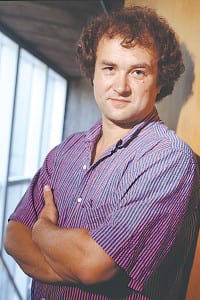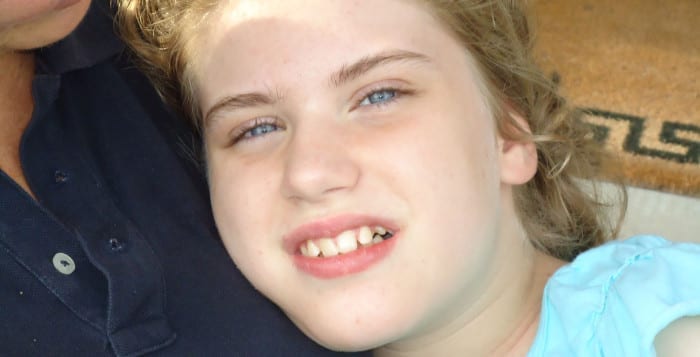Chelsea Coenraads speaks through her eyes. She shows her family how much she loves them with slight changes in her expression. Her family “tries to get her to smile all the time, because her smile can make the darkest situations be okay,” said her mother, Monica Coenraads.
At 18 years old, Chelsea, who lives with her parents in Trumbull, Connecticut, has spoken only one word, when she was a toddler, “duck.” Carrying a disorder that occurs in one out of every 10,000 live female births, Chelsea has Rett Syndrome. Under constant supervision, she has no hand function, spends her days in a wheelchair and is fed through a feeding tube.
But, “she’s so much more than her laundry list of symptoms,” her mother said.
Recently, Monica Coenraads, who cofounded the Rett Syndrome Research Trust, became aware of research at Cold Spring Harbor Laboratory. Professor Nicholas Tonks and his postdoctoral student, Navasona Krishnan, published a study in the Journal of Clinical Investigation in which they inhibited an enzyme Tonks called PTP1B, for protein tyrosine phosphatase.
Tonks and Krishnan demonstrated that male mice with a disorder that comes from an X-linked mutation in a gene called MECP2 lived 75 days, compared with the typical 50 days without the inhibitor. Meanwhile, female mice stopped doing paw gestures that are a model for hand gestures often encountered in patients with Rett.
“We now have a new tool for manipulating a molecular signaling pathway which we already know is deficient in mice models of Rett Syndrome and, we believe, in human patients as well,” said David Katz, a professor of Neuroscience and Psychiatry at Case Western Reserve University School of Medicine who has spent more than a decade studying Rett. Katz started collaborating with Tonks last month.

“We believe there are multiple pathways that make promising targets for drug therapy,” said Katz, who completed his Ph.D. at Stony Brook in 1981. By combining a series of treatments, scientists and doctors might be able to offer those with Rett Syndrome a drug cocktail, Katz suggested.
Tonks cautioned that the results are an encouraging step, but there is considerable work to do before this promising result can lead to a possible therapy.
“We are a long way from a treatment for the disease,” Tonks said “A lot more work needs to be done to define more precisely how inhibiting PTP1B would impact Rett patients.”
Tonks’ interest in Rett Syndrome started a few years ago, when Krishnan attended a lecture from another postdoc at Cold Spring Harbor Laboratory.
Krishnan “proposed the experiments in the first place,” Tonks said. “He is responsible for performing the studies.” Tonks credited the other co-authors on the paper for making important contributions, including Keerthi Krishnan, who gave the lecture several years ago that triggered Tonks’s interest. Keerthi and Navasona are not related.
The inhibitor used in these studies was something Tonks and his partners developed several years ago to treat diabetes and obesity at a company called CEPTYR Inc. that has since halted its operations.
As the first to purify protein tyrosine phosphatase, Tonks has generated interest in this family of about 100 proteins among other scientists.
“Before [Tonks’s] initial work, the nature of the enzymes that took phosphates off was obscure,” explained Dr. Benjamin Neel, director of the Laura and Isaac Perlmutter Cancer Center at NYU Langone Medical Center.
Neel, who described Tonks’ reputation as “stellar,” was a postdoc when Tonks purified the first member of this family. “When I saw that paper, I immediately decided this was going to be a major area and I needed to work on it.”
Tonks, who was born and raised in the United Kingdom, came to the United States to work with the pioneers in the signaling field, he said.
Tonks is married to Catriona Simpson, who also has a Ph.D. in biochemistry and works at Cold Spring Harbor Laboratory as an editor. The couple, who live in Huntington, have a 23-year old daughter, Clare, who is getting her master’s degree at Columbia University in English and History, a 19-year old son, Nicholas, who is interested in aviation management, and a 16-year old daughter, Caroline, who wants to become a ballet dancer.
Tonks expressed cautious optimism that he, Krishnan and his lab could help make a difference for the lives of people with Rett Syndrome.
Katz shared a quote from Andreas Rett, a physician from Vienna, Austria, who first recognized the disease.
“Their eyes are trying to tell me something,” Rett said. “I just don’t know what it is.” Katz said that is one of the factors that inspires him to search for effective treatments.
Those would like to learn more about Rett, or donate to research, can do so through www.rsrt.org.





